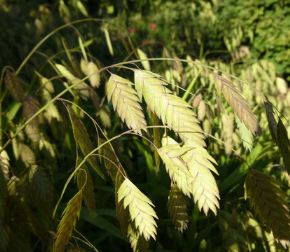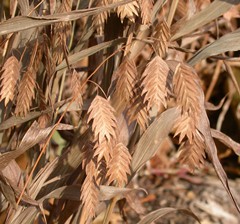Northern Sea Oats, Chasmanthium latifolium, is a clump-type grass that grows up to 36 inches tall in bloom and is 18 inches wide. The grass blades are deep, bright green and grow up to 12 inches long. In summer, the green flowers develop into seed heads that are oat-like spikes and look like overlapping fish scales (photo by Zoya Akulova from eol.org).The seed heads last throughout the winter. Due to the longevity of the seed heads, Northern Sea Oats is useful as a cut flower for fall arrangements, as well as a good plant for winter interest in the landscape.
Northern Sea Oats will grow in any sunlight condition - from full sun to full shade. It does best in partial shade where the grass blades will have a darker green color. It is unusual for grasses to grow in the shade, so this is a great plant for areas with that type of light condition. This is a good grass for almost any environment because it is tolerant of consistently wet soils, drought tolerant once established, and does well in most ranges of soil fertility.
Consider using Northern Sea Oats as a specimen plant, as a mass planting in a landscape setting, or in a naturalized area or prairie. Northern Sea Oats is a great choice for prairies and other acreage locations because it can fill in an area quickly. It can be invasive in some situations because it will reseed and can spread by rhizomes. If you don't want it to spread, remove the seed heads in the fall.
This grass provides good food for wildlife and is good habitat for some species of birds, offering food (seeds) as well as cover. In addition, it attracts butterflies and is a good plant for the butterflies to lay their eggs on. According to the University of Texas at Austin, it is deer-resistant, so deer should not destroy it.
Prairies and other landscape settings tend to turn brown and dreary in November, but that is not the case with plants like Northern Sea Oats. The seed heads will add a great deal of interest for the entire winter (photo from Iowa Extension). This plant is a great choice to draw in wildlife, too. If you are looking for a new grass for your prairie, a grass for your landscape, or something to make a screen in your landscape, consider Northern Sea Oats.


